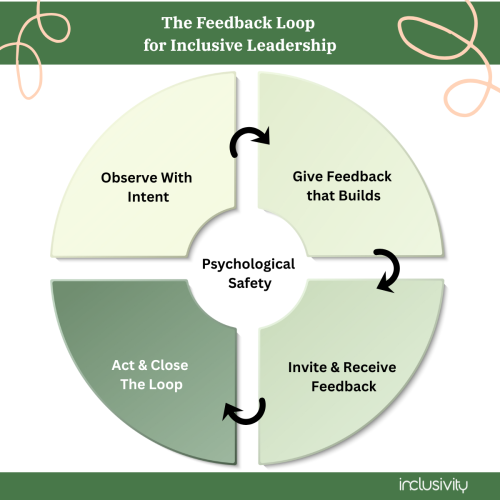If we want high performing cultures that are innovative, accountable, and inclusive, we need leaders who treat feedback not as a task, but as a practice.
Leadership today isn’t about following a rigid playbook, it’s about navigating complexity with adaptability, empathy, and cultural awareness. In a world of accelerating change and growing diversity, effective leadership is not just a role; it’s a relational and cultural force. It shapes how people feel, how they connect, and how they grow.
The leaders who thrive today are those who build trust, invite collaboration, and foster environments where people feel seen, supported, and stretched. They recognize that organizational culture isn’t built through posters or mission statements, it lives in the everyday interactions, decisions, and conversations that leaders model.
And at the heart of that culture? Feedback.
Feedback as a Cultural Practice
Too often, feedback is framed as a performance management tactic, a corrective tool for managing mistakes or improving outcomes. But in reality, feedback is one of the most powerful ways leaders can build trust, strengthen relationships, and embed a learning culture.
In thriving workplaces, feedback is not reserved for annual reviews. It’s part of the everyday rhythm of work: clear, consistent, and authentic.
Done well, feedback is a form of care. It says, “I see you. I believe in your growth. I trust you enough to be honest.”
Giving Effective Feedback
Leaders who give strong feedback do more than offer observations, they shape culture. Here’s what effective feedback looks like:
- Make it timely and specific. Don’t wait. Ground feedback in a specific moment, action, or impact. Specificity fuels clarity and change.
- Balance positive and constructive input. Research shows high-performing teams operate with a 5:1 ratio of positive to constructive feedback. That balance builds psychological safety and keeps people open to growth.
- Reinforce values. Use feedback to celebrate behaviours that align with your team’s values, like collaboration, curiosity, or trust.
- Focus on behaviours, not personalities. Stay anchored in what someone did, not who they are. This keeps conversations grounded and respectful.
Receiving Feedback as a Leader
It’s not enough to give feedback well, leaders also need to receive it well. When leaders invite and respond to feedback, they model humility, openness, and trust.
- Choose curiosity over defensiveness. Feedback might be hard to hear, but it’s even harder to give. Respond with openness and gratitude.
- Ask often. Normalize feedback by making it part of regular dialogue. “How could I have handled that differently?” or “What support do you need from me?” opens the door.
- Acknowledge, learn and act. When someone offers feedback, thank them, and if the insight is valid, take visible action. That signals feedback isn’t just welcomed, it’s valued.
Why Feedback Matters for Culture
In cultures where feedback flows freely, learning becomes part of the norm. People speak up. Teams move faster, silos shrink and everyone feels more connected to a shared purpose.
Conversely, cultures where feedback is avoided, especially at the leadership level, are often marked by low trust, stagnation, and unresolved tensions. Unaddressed issues persist, opportunities are missed and performance plateaus.
Feedback isn’t just about correction, it’s about connection, clarity, and alignment. It’s one of the most human expressions of leadership, and one of the most effective levers for building strong, inclusive, high-performing cultures.
The Leadership Imperative
If we want high performing cultures that are innovative, accountable, and inclusive, we need leaders who treat feedback not as a task, but as a practice.
The Feedback Loop for Inclusive Leadership offers a simple but powerful framework to embed feedback into your leadership practice in a way that fosters psychological safety, inclusion, and accountability.

Quadrant 1: Observe with Intent
- Actively notice behaviours, contributions, and challenges.
- Pay attention to team dynamics, patterns, and moments that reflect your values (or deviate from them).
Quadrant 2: Give Feedback that Builds
- Be timely, specific, objective, and behavior-focused.
- Balance praise and constructive input.
- Reinforce cultural values (e.g., collaboration, inclusion, accountability).
Quadrant 3: Invite and Receive Feedback
- Ask for feedback regularly and sincerely.
- Actively listen without defensiveness and demonstrate curiosity, not control.
- Reflect and thank the person who shared.
Quadrant 4: Act and Close the Loop
- Adjust your actions or decisions visibly.
- Follow up. Let people know how their feedback made a difference.
- Keep the loop alive by making feedback a habit, not an event.
At the center of the loop is Psychological Safety. The loop only works when people feel safe to speak up and trust they’ll be heard. The more feedback is embedded into daily practice, the more psychological safety grows—making it easier for everyone to contribute, challenge, and innovate.
In today’s world of work, leadership isn’t just about getting results, it’s about creating the conditions where people can do their best work. And feedback is one of the most powerful ways to get there






















